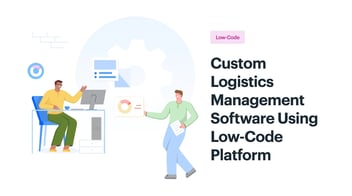Related Articles

5 MINUTES READ
Low-Code for the Manufacturing Industry Guide
5 MINUTES READ
Types of Low Code Platforms Explained for Enterprises
In the evolving digital landscape, Gartner projects that by 2024, 65 percent of application development will be driven by low-code and no-code platforms. A TechRepublic report further underscores this shift in development paradigms, indicating that 60 percent of custom applications are now created outside traditional IT departments, with 30 percent of these developed by individuals possessing minimal to no technical skills.
The advent of custom applications has ushered in a new era of operational efficiency for businesses. No longer shackled by cumbersome paper trails, convoluted spreadsheets, and manual data entry, organizations that have adopted custom apps now enjoy streamlined business processes. However, the inherent challenge lies in the fact that not everyone possesses coding expertise.

Thank you for downloading!
Enter low-code platform - an innovative solution designed to bridge this gap. When your IT team is inundated with an ever-growing list of tasks akin to the length of the Great Wall of China, relying on extensively coded applications is far from feasible. Low-code platforms empower you to create applications irrespective of your coding prowess. They cater to most requirements, and only in instances where pre-existing templates don't meet specific needs does the need for manual coding arise.
You might wonder, "What if my coding proficiency is practically non-existent?" Fear not. The beauty of low-code platforms is their accessibility and ease of use, making them the ideal choice for today's CIOs seeking efficient, scalable solutions for their organizations.
Learn more: Difference between Open source vs. licensed low-code platform
Just like low-code systems changed the custom app game, no-code is a revolutionary step that’s quickly being embraced by organizations worldwide.
Say you’re the expert on a particular task in your company’s workflow. Maybe it’s the stages involved in getting a purchase order signed or something as simple as a lasagna recipe at the restaurant you work for. With a no-code platform, you can develop apps that will ensure the process gets completed as efficiently as if you were watching over every step—with the added advantage that you don’t need to know coding!
Think of low-code application platform as a quicker way for professional developers to create solutions, helping your IT team service other business requests. On the other hand, no-code enables the business developers themselves to create apps that solve workflow bottlenecks and other business process efficiency issues.
One makes coding easier and faster for the coders, while the other removes the need for the coder to even come between the solution and its original designer. It’s a step further, and many businesses around the world agree.
In a 2018 study of custom apps and their scope, 91 percent of respondents felt that productivity levels were up, with 51 percent stating that it was up by as much as 40 percent. In the same study, 76 percent of respondents reported a positive spike in ROI.
If every process expert was given the tools to ensure efficiency—without the ‘you should know coding’ barrier—the results are quite obvious.
Learn more: What is zero code platform - Complete Guide
Yes, no-code development is much simpler and more intuitive than low-code, but there’s more to this approach.
Less code means smaller bills, and no-code takes this a step further than low-code. Low-code programming may be cheap, but no-code literally does away with coding costs. When you solve a problem, you don’t have to spend extra on a coding middleman who brings nothing but coding ability to the table.
A study showed that 63 percent of corporate IT professionals name speed as the need of the hour when it comes to productivity solutions. When no time is lost in coding, solutions are developed faster, and efficiency is immediately boosted.
You don’t need the GitHub community to confirm this one: it’s a fairly logical assumption that less coding means fewer bugs to iron out.
It may sound like wishful thinking, but no-code platforms are logically likely to replace the low-code model for a single, solid reason: this development follows the path of least resistance.
Learn more: Key difference between Low-Code vs RPA and which One is right fit
CaratLane, India's largest online jewelry retailer, faced challenges with rapid growth and expanding operations. Ajith Singh, Head of Product Management, needed a solution to streamline operations without overburdening the IT team.
The company struggled with a lack of developer support, inefficient post-order processes, and accountability issues. Singh turned to Kissflow, a workflow automation platform, to address these issues. Using its no-code/low-code capabilities, Singh quickly developed applications for warehousing, quality checks, accounting, and customer service.
Kissflow led to increased customer satisfaction, reduced IT dependency, enhanced accountability, and enabled the speedy creation of custom apps. Since 2017, CaratLane has used Kissflow to effectively manage its growth and operations.
Learn more: What is Technical Debt assessment for business leaders and IT teams
The future of low-code technology is expected to be bright, as it has been growing in popularity and demand, especially with the rise of digital transformation initiatives in various industries. The low-code global market is forecasted to be around $65 billion by 2027 and $187 billion by 2030. That’s a CAGR of 31.1 percent between 2020-2030.
No-code platform are slowly but surely edging out their older low-code siblings.
With a 93% reduction in inefficient tasks offered by an app, you can get running in under three months without any coding; there’s no denying it—we have a clear winner on our hands.
“Customers are more than satisfied and actively compliment us on how fast we’re able to solve their issues, answer emails and answer their calls all in real-time.”
Chase Holden, Merchant Services North America
Looking into the next few months and years, it’s easy to see that we’re looking at a reality where businesses of all types are developing their own apps to streamline the productivity and efficiency of their everyday running.
Kissflow is a unified low-code, no-code platform that bridges the gap between business users and IT to simplify process management and dramatically accelerate digital transformation and it’s ridiculously easy to use. Business users can take control of their digital needs while IT leaders can continue providing a secure and scalable platform for digital growth.
1. How will AI influence the future of low-code development?
AI will accelerate app creation through automatic form generation, process recommendations, and intelligent error detection. It will help both IT and business users build solutions faster with fewer iterations.
2. What trends will shape enterprise adoption of low-code platforms?
Key trends include deeper integrations, improved governance frameworks, stronger support for external collaboration, and increased use of automation across departments.
3. How will low-code change the role of IT teams in the future?
IT will shift toward platform governance, architecture design, and integration strategy rather than building every application. This creates a more scalable development ecosystem.
4. Will low-code replace traditional development?
Low-code will not replace traditional development but will complement it. Complex systems still require coding, while low-code handles workflows, departmental apps, and iterative automation.
5. How will organizations balance speed and control as low-code evolves?
Enterprises will adopt stronger guardrails, reusable components, and centralized governance models to maintain control while enabling rapid delivery across teams.
6. How will low-code support large-scale digital transformation initiatives?
Low-code enables faster modernization by allowing teams to digitize processes incrementally. Its speed and adaptability help organizations evolve continuously instead of relying solely on multi-year transformation projects.
Related Articles


Welcome.
Let's get started.
To begin, tell us a bit about yourself
By proceeding, you agree to our Terms of Service and Privacy Policy
"The beauty of Kissflow is how quick and easy it is to create the apps I need. It's so user-friendly that I made exactly what I needed in 30 minutes."
Oliver Umehara
IT Manager - SoftBank
A Trusted Choice for Companies Globally




Thank you for signing up
Someone from our team will contact you soon.

Know why all the IT leaders converging at booth #602
Earn a chance to be part of our experience event

Get the first look at the 2025 CIO Trends report
Welcome.
Let's get started.
By proceeding, you agree to our Terms of Service and Privacy Policy
Wondering where to start?
Let's talk!
Connect with our solution experts to gain insights on how Kissflow can help you transform ideas into reality and accelerate digital transformation


Leaving without your free low-code resource?
This website uses cookies to ensure you get the best experience. Check our Privacy Policy
